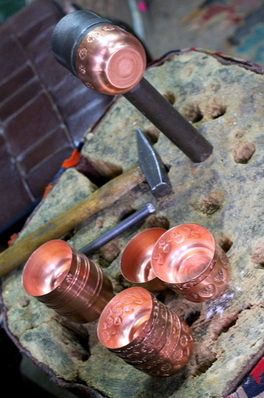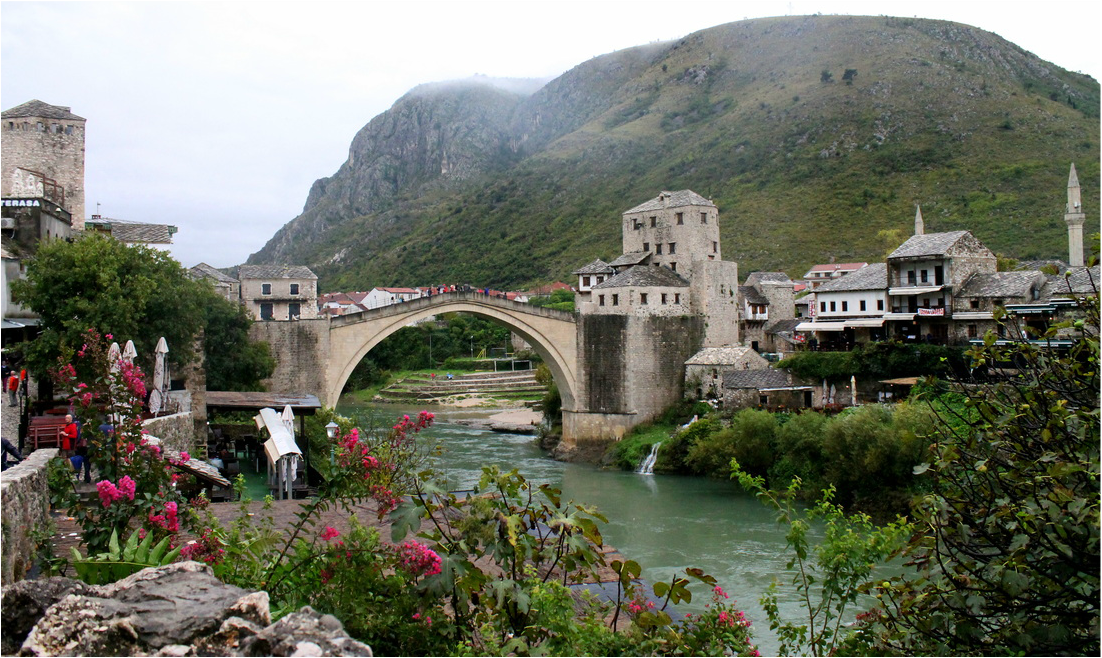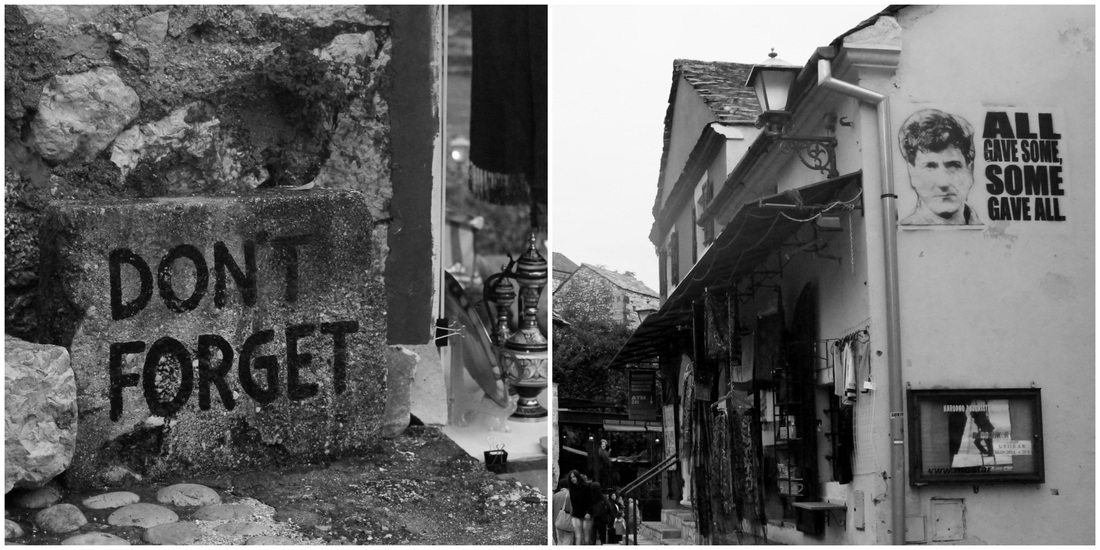|
One day during our time in Bosnia we made a visit to the city of Mostar, a cultural center and UNESCO World Heritage Site famous for its Ottoman-era bridge. The duration of our time in Mostar was spent huddling under umbrellas and avoiding the torrential rainfall as we went on a walking tour around the “Mediterranean” city. Our tour guide shared with us how the war impacted Mostar. She explained how Mostar has an Austro-Hungarian side and an Ottoman side. During the war, Orthodox Christians moved to the Austro-Hungarian side and Muslims moved to the Ottoman side, to the point where people swapped apartments. It sounds so ridiculous and implausible, yet it happened. When asked how things are now that the war is over, she said that although there is now freedom of mobility between both sides, things continue to be, for the most part, “ethnically” segregated. This is one of the ironies of Bosnian war. Although Bosnia is very religiously diverse, most Bosnians are the same ethnicity. Although the war was really about territory, Muslims were targeted and “ethnically” cleansed. When our tour guide mentioned how Mostar continues to be ethnically segregated, with “Bosnian” schools, “Croat” schools, and “Serb” schools – because they all prefer their own language – it’s kind of absurd. They all speak the same language, there are just small variations like the difference between American and British English. Twenty years later, the legacy of the war in Mostar is heartbreaking. After our walking tour was over, we spent the rest of the day wandering the picturesque streets of the Ottoman side of town. We took in the gorgeous view of the Stari Most Bridge, Mostar’s pride and namesake (Mostar means “keepers of the bridge”). The original bridge was built in the 16th century and stood for 427 years before it was tragically destroyed by Croat forces in the war. Can you imagine the sorrow on that day? Although the old bridge can never be fully replaced, a coalition was put together following the war to reconstruct the bridge and the new Stari Most was reopened in 2004. The Need for Economic Opportunities and Holistic Development In talking with Belma, the historian at the tunnel, and Gina, one of the women who runs the Pansion Lion hostel we stayed at, it became clear that Bosnia is really struggling economically. According to the CIA, the war caused production to fall by 80% and spiked unemployment (1). Belma reported that the economy has been very slow to recover and this is evident, still, with a GDP per capita of $8,300 and a staggering unemployment rate of 44% (1). Gina, a mother, wife, and young professional, shared with me that despite having a master’s degree she has been unable to find a job, which is why she is still helping her mother and sister run the Pansion Lion. Frustrated, she explained how several of her friends are in similar situations: well-educated, bright, young, and eager to work, but unable to find jobs that pay well. Gina has had a few offers, but the salary would barely cover the cost of living, transportation, and childcare, so she has declined them. I spoke with another woman in Sarajevo who works at her family's coppersmithing store and workshop. An old tradition in Bosnia, her family has owned and run their shop for 250 years, five generations. While buying carefully-crafted tea pots and coffee sets from her, she was telling us how hard it is nowadays for her family to make a profit on their business. Maybe she was telling us this in hopes that we would buy more, maybe she was just making conversation, but it confirmed what Belma and Gina had told me about the country’s economic situation.  The poverty in Bosnia surprised me. Hearing about the struggling economy. Seeing a number of children begging, even late at night alone on the streets. Observing the dilapidated buildings cities can’t afford to repair and the broken down cars left to rust in people’s yards. Driving the scenic route from Sarajveo to Mostar reminded me of many drives I've had through rural areas in developing countries. However the difference in Bosnia was the lack of NGO signs lining the road. Not that non-profits are the solution, because their presence often comes with its own set of issues, but it confirmed what I've been noticing for a while now, that Eastern Europe is often a forgotten place. Eastern Europe is forgotten about by the developed world, it isn't a major political or economic player. It’s forgotten about by the developing world and development sector, it’s still apart of "affluent Europe", after all, and there indeed are places where things are worse economically. I don’t recall ever learning about modern Eastern Europe in history classes growing up and even now in my development classes our discussions tend to focus on the “more” developing countries of the world - i.e. Sub-Saharan Africa, Central and South America, Central and South-East Asia, occasionally the Middle East, and so on. Even when I hear about the work of various non-profits, or check out the "Where We Work" sections on their websites, I rarely see countries in Eastern Europe listed. Even for organizations that do work in Eastern Europe, there can still be challenges that may stem from a belief on the part of donors that Eastern Europe doesn't really need the help as much as other places. When I interned with World Vision I remember some employees mentioning how it is more difficult for the organization to find sponsors for children in their Eastern Europe programs; people want an African kid. It’s more "glamorous," as repulsive as that is. The poster children for fundraising campaigns are also more often than not individuals of color. I remember hearing that, statistically, featuring African or African-American children in non-profit marketing "sells better" then featuring children of any other ethnicity. Although the majority of economically poor countries in the world are centered in Sub-Saharan Africa, development work should not stop there (2). Just because people are white, whether they live in Detroit, London, Sarajevo, or Bucharest, doesn't mean they, we, don't need help. Just because people are earning a living, however small or large, doesn't mean they have "arrived" at the magical state of "developed" and no longer need any sort of assistance. Although economic development is very necessary in most places in the world, holistic community development and loving your neighbor is so much more than just increasing income or dumping aid on the "destitute" countries of the world. In Bosnia, from my very short visit, in addition to increased economic opportunities, it is apparent that reconciliation needs to happen and political and community leaders need to be mentored and developed. Minorities, like the Roma population that often live on the margins of society, need to be cared for and integrated and welcomed into the larger community. In the majority-white suburbs I grew up in, families need to be strengthened. Neighborhoods need to become real communities where people actually know and care for one another. We need to create solutions to growing issues of substance abuse and mental illness. These goals are often less measurable and may not look as impressive on an annual report, but they are necessary to creating long-term, sustainable transformation - from the U.S., to Botswana, to Bosnia. As someone hoping to work with economic and community development, visiting Bosnia raised some of these difficult questions for me and most certainly pulled on my heartstrings. It deepened my desire to work in, or with, the region of Eastern Europe someday and to get to know its beauty and complexities more. Click here to read BiH Part 1
0 Comments
Leave a Reply. |
Archives
May 2017
|


 RSS Feed
RSS Feed
